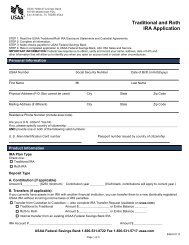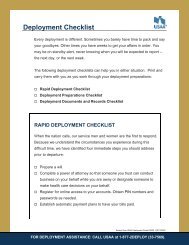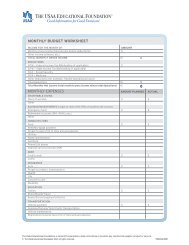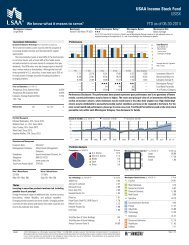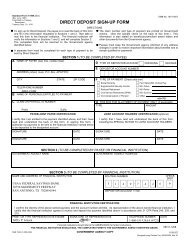Prospectus - USAA
Prospectus - USAA
Prospectus - USAA
Create successful ePaper yourself
Turn your PDF publications into a flip-book with our unique Google optimized e-Paper software.
edemptions from mutual funds that hold large amounts of fixed-income<br />
securities. Such a move, coupled with a reduction in the ability or willingness of<br />
dealers and other institutional investors to buy or hold fixed-income securities,<br />
may result in decreased liquidity and increased volatility in the fixed-income<br />
markets. Heavy redemptions of fixed-income mutual funds and decreased<br />
liquidity of fixed income securities could hurt a Fund’s performance.<br />
State-Specific Risk: Because the Funds invest primarily in California taxexempt<br />
securities, the Funds are more susceptible to adverse economic, political,<br />
and regulatory changes affecting tax-exempt securities issuers in that state. For<br />
more information, see the SAI.<br />
Structural Risk: Variable-rate demand notes (VRDNs) are generally longterm<br />
municipal bonds combined with a demand feature that is used to shorten<br />
the maturity. The demand feature represents the right to sell the instrument back<br />
to the remarketer or liquidity provider, usually a bank, for repurchase on short<br />
notice, normally one day or seven days. Usually the demand feature is backed<br />
by a letter of credit or similar guarantee from a bank. Since we are relying on the<br />
demand feature to shorten maturity, the ability to exercise the demand feature<br />
would be dependent upon the bank. We would only purchase VRDNs where we<br />
believe that the banks will be able to honor their guarantees on the demand<br />
feature.<br />
Some VRDNs, sometimes referred to as “structured instruments” or “synthetic<br />
instruments,” are created by combining an intermediate- or long-term municipal<br />
bond with a right to sell the instrument back to the remarketer or liquidity<br />
provider for repurchase on short notice, referred to as a “tender option.” Usually,<br />
the tender option is backed by a letter of credit or similar guarantee from a bank.<br />
The guarantee, however, is typically conditional, which means that the bank is<br />
not required to pay under the guarantee if there is a default by the municipality<br />
or if certain other events occur. We will not purchase a synthetic instrument<br />
unless counsel for the issuer has issued an opinion that interest paid on the<br />
instrument is entitled to tax-exempt treatment. Because there is the risk that the<br />
Funds will not be able to exercise the demand feature at all times, we will not<br />
purchase a synthetic instrument of this type unless we believe there is only<br />
minimal risk that we will not be able to exercise our tender option at all times.<br />
Other types of tax-exempt securities that are subject to structural risk include<br />
LPP shares and other similar securities. LPP shares are a relatively new type<br />
of investment, the terms of which may change in the future in response to<br />
regulatory or market developments, which could adversely impact the value<br />
and liquidity of the Fund’s investment in LPP shares, the tax treatment of<br />
investments in LPP shares, or the ability of a Fund to invest in LPP shares.<br />
27 | <strong>USAA</strong> California Funds



